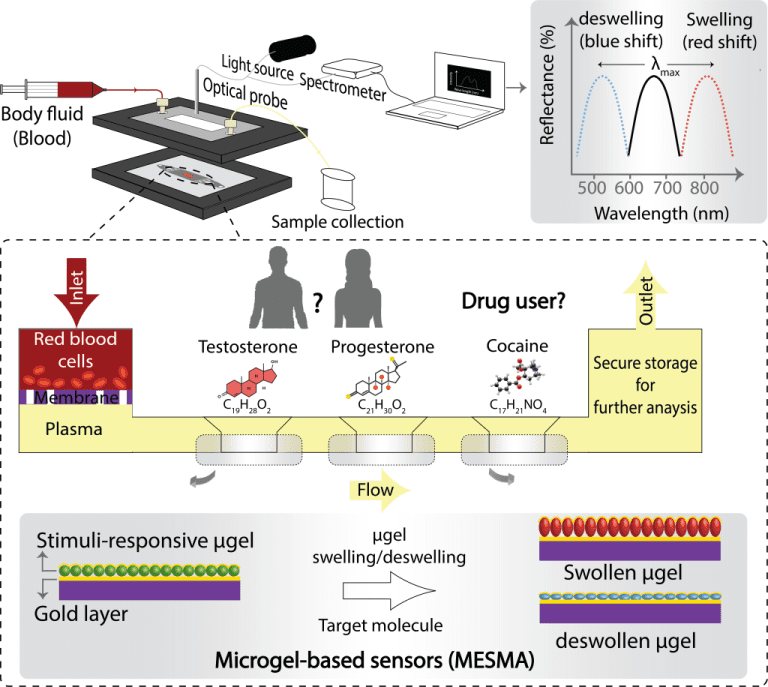Hanieh Bazyar aims to speed up forensic investigations. “We should move from hours to minutes.” The scientist is developing a device to analyse bodily fluids at crime scenes.
Hanieh Bazyar is developing a chip that can test blood on the spot. (Photo: private collection)
English only
Hanieh Bazyar, Assistant Professor at the Engineering Thermodynamics section (Faculty of Mechanical, Maritime and Materials Engineering), is an expert in the field of microfluidics and membrane separation technology. This week, on June 7, she will be one of the speakers at the How can advanced technologies boost criminal investigations? symposium to be held at the Police Academy in Apeldoorn. In her lecture, she will discuss how microgel-based technologies could be applied in the field of forensics.
Does your research focus on applications in forensics?
Bazyar replied, “I’m developing a Separation Sensing Platform, which is a microfluidics application for biomedical diagnosis. Essentially, I’m aiming to develop a chip-based device that can be easily used on site, such as a crime scene, to detect specific biomarkers from bodily fluids. It can be used to detect drugs, like cocaine, but also sex hormones to determine if the sample comes from a male or a female. The platform can also be applied for diagnosis in a medical setting, but forensic applications are certainly a part of my work.”
How far along are you with the development of this platform?
“We have the chip ready, and we are looking to start testing with blood samples in the near future.”
Your lecture at the upcoming symposium is titled Forensics-on-a-chip: How and where to apply microfluidics in the forensic field?. Is microfluidics currently applied in forensics?
“Yes, some microfluidic-based technologies have been developed for use in forensics, but most of them only in the lab setting. For instance, body fluid identification, genetic profiling, human identification, drug analysis and analysis of explosive residues. There are commercial platforms available for rapid DNA testing known as “swab-in-profile-out”, but there are only a few – and they are still not fully accepted by the forensic society.
‘My goal is to help criminal investigators decide on next steps faster’
Forensic experts are conservative in adopting new methods because whatever they use needs to stand up in court. The methods can possibly decide someone’s fate.The microfluidics technologies haven’t been standardised yet, and that is key. Moreover, they are not well integrated into the existing methods. Each method in forensics includes several steps, and microfluidics applications are often developed for only one of them, while the rest are done off chip. We need to develop a platform that empowers existing methods, not competes with them. That is precisely the idea behind my research. My goal is to provide quick detection, and help criminal investigators decide on next steps faster.”
How much faster is your platform compared to existing methods?
“We should move from hours to minutes. There are already presumptive tests, which are very fast. You might have seen this on TV shows. A chemical compound called luminol is often used to see if the liquid on scene is blood or not. It shows blood as chemiluminescent blue under a UV light. Such methods are fast, but they don’t provide any detailed analysis, and they can potentially destroy the sample. If the investigators want to test the bodily fluids for gender and drug analysis, they have to send the samples to the lab. Because labs are often overloaded, it can take days before the results are known. With our platform, we aim to provide the information within ten to fifteen minutes.”
Besides the speed, are there other advantages to using microfluidics in forensics?
“It removes the chance of cross-contamination because the sample goes straight into the device. Microfluidics have a small footprint. They allow us to fit many components into one small and portable platform. It is also user friendly. Anyone should be able to use it without any prior training. You could compare it to the COVID-19 self-tests we have all been using.”
What type of impact do you hope to achieve with your research?
“I’d like to see the platform used not only for criminal investigations, but also for health monitoring at home and for sport activities. More specifically, I envision using it for antidoping analysis directly in the field. I want to provide a platform that is as fast and as accurate as possible.”
- How does it work?


Microgel-based Etalon Spectrophotometry in Microfluidic Appliance (MESMA) works with microgels that have been made sensitive to specific molecules. If a drop of blood is placed at the inlet, only the blood plasma passes through the chip with microgels. Blood cells remain behind. If the plasma contains molecules for which the gel has been sensitised, the gel will swell or shrink, which will change the distance between the reflective layers sandwiching the gel. This variation in distance will change the reflected colour of the laser like a thin film of oil on water does. The presence of certain molecules (testosterone, progesterone, cocaine) will thus become detectable as a colour change in laser light.
Heb je een vraag of opmerking over dit artikel?
michaela.nesvarova@gmail.com


Comments are closed.